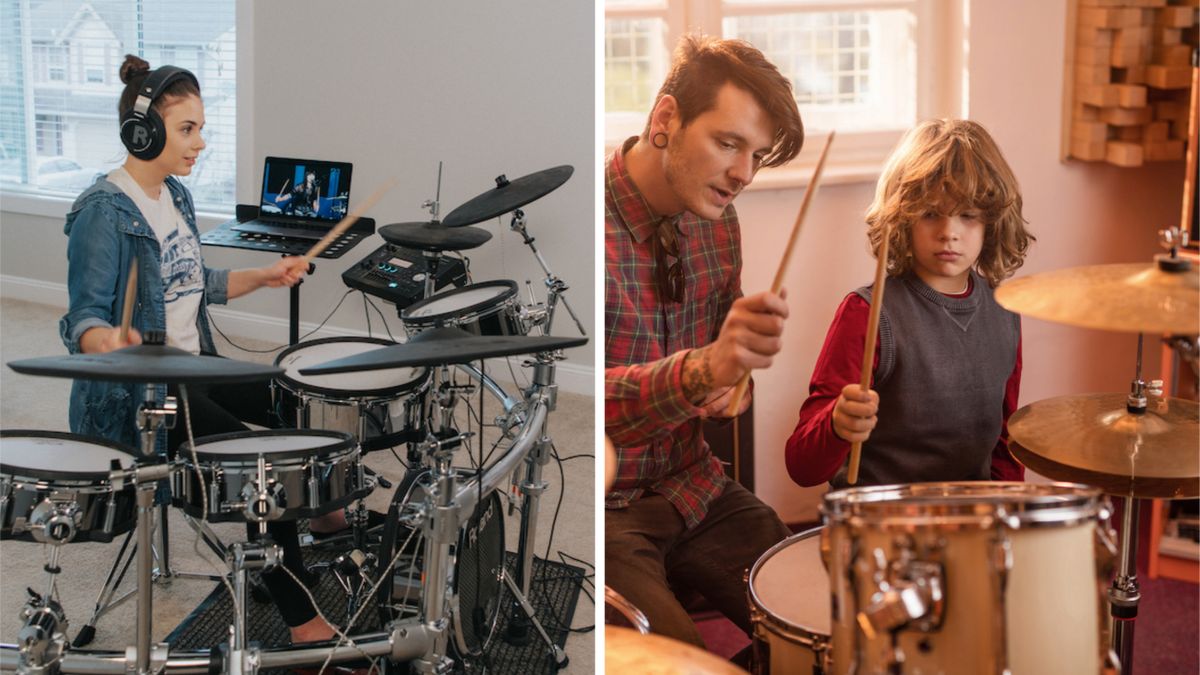Online vs face-to-face drum lessons: which one is right for you?
There was a time when the only way to learn the drums was to personally seek out a good teacher. These days, the answer to any drumming-related question is just seconds online and often accessible in the palm of your hand. Does this modern method of online learning completely replace the need for a traditional drum teacher, or is there no substitute for good old-fashioned face-to-face learning? Each method comes with its own list of advantages and disadvantages which we will discuss in this article on online drumming lessons versus face-to-face lessons.
It should be noted that we classify online lessons via Skype or Zoom with a private instructor as “face-to-face”. Online drum lessons could also include free content via social media platforms or YouTube, but also more specialized subscription services such as DrumeoMike’s Lessons or Drum Channel.
1. Cost
With online drum subscription services offering fixed monthly rates for unlimited access to course content, the online option is pretty much guaranteed to be the cheapest option here. Most also offer a free trial period to help you decide if this is the platform for you before paying.
Aside from the thousands of lesson videos available for free on Youtube, even a paid service like Drumeo will cost less per month than taking a single 60-minute private lesson (based on a one-hour lesson costing between $40 and $60 for a monthly Drumeo of $29). subscription). An in-person drum tutor naturally won’t be able to compete with these prices, although costs can be reduced somewhat by booking in bulk or taking group lessons.
When it comes to free online courses, while we understand the lack of cost will be attractive, it’s often much more difficult to find the right content with the right structure to meet your needs as a gamer when you borrow this way. We always recommend looking for a paid option. As the old saying goes, you get what you pay for.
2.Interaction
A potential downside to online drum lessons is the often one-sided nature of video lessons, due to the lack of personal interaction with a tutor or even other students. Let’s say you decide to learn the drums through YouTube videos – other than maybe leaving a comment on the video, there’s really no possibility of a conversation with the person teaching you. That said, spending a little money on a premium online service opens up the possibility of greater interaction through personalized messages, videos, and feedback on your game. Taking face-to-face lessons is not only better for building a relationship with your tutor, but also opens up the possibility of meeting other like-minded people through their network of students.

3. Feedback
Regular feedback is an essential part of learning any instrument and without it it’s easy to fall into bad habits. You would struggle to develop bad habits under the watchful eye of a private tutor, as they are able to provide real-time feedback on things like technique and timing. Online learning can mean a lack of opportunity for that valuable feedback. That said, many online services allow students to submit videos of themselves playing to receive written or recorded feedback. by Mike Johnson mikeslessons.com (opens in a new tab) and Dave Weckl’s online school (opens in a new tab) are excellent examples.
4. Convenience
There’s no doubt that one of the reasons drummers are drawn to online learning is the ability to fit their learning into their own schedule. With pre-recorded lesson content, there’s never a bad time to pick up the sticks and develop your skills (as long as the neighbors don’t care). This could be beneficial for someone who is not available during normal class hours or who may not have the time to commit to regular classes. Having the ability to take a break during a lesson is also a welcome addition, although with a good teacher you should be able to work at your own pace without feeling rushed or rushed.
Many in-person lessons are held at music schools or music stores, which means that signing up for lessons comes with the added benefit of joining a local community of musicians. Many music schools will create opportunities for interdisciplinary students to meet and form bands. It gives us drummers the chance to meet guitarists, bassists, vocalists and more – in some cases forming our first bands.
Educational institutions also often offer live performances, an invaluable experience for budding musicians. This is a specific benefit of having a local teacher who will not necessarily come with Zoom/Skype lessons and will rarely be available through an online platform. That said, we’re starting to see platforms like Drumeo and Mike’s Lessons hosting in-person drum camps for their students online. We’ll probably see more of this in the future.
6. Progress
It is difficult to say which method will allow a student to progress the most because it largely comes down to the time spent learning and practicing each week. However, we can draw comparisons on progress tracking, which is an extremely important part of learning lessons. Same vicfirth.com (opens in a new tab)which has a fantastic (and free) educational space, tracks all 40 rudiments via bronze, silver, gold, platinum, and diamond medals for each rudiment.
Paid online services largely focus on goal setting with opportunities to track progress. But, in our opinion, face-to-face tutors have the win here because they can not only help set and achieve personal goals, but also provide detailed feedback on progress.

7. Beginners
For someone who picks up a pair of drumsticks for the first time, it can be a daunting world of information. As we discussed above, searching the internet for “how to play drums” or “drums for beginners” might be the first port of call for many. With so many posture and technique considerations, getting started on an instrument is the most likely time when bad habits will form. With this in mind, we recommend that you either pay for an online subscription to a dedicated platform with a well-thought-out and well-structured beginner’s program, or seek out a tutor for at least one or two face-to-face lessons. to understand the basics.
8. Access to famous names
One of the amazing things about learning drums online is access to famous drummers; many of whom don’t even teach in person. Look no further than the legendary Ringo Starr who, incredibly enough, has a Drumming and Creative Collaboration video course available at masterclass.com (opens in a new tab). On the same website, you can also find Shelia E. Teaching Drumming and Percussion.
Drumeo is another brand that regularly attracts “celebrity” tutors, giving you that rare opportunity to learn from your heroes. There are plenty of big-name drummers teaching face-to-face lessons (especially since the pandemic), although it’s unlikely to find one in the area. Lessons on Skype or Zoom would probably be the best way to enjoy this face-to-face with your drum heroes.
9. Course quality
The quality of lessons is something that can vary wildly, whether online or face-to-face. In terms of digital delivery, production values are hugely important – where multiple camera angles and high quality sound have become the most basic requirements – not to mention decent course content!
In-person tutors do not necessarily have the same concerns here, although providing the necessary equipment is important to the quality of course delivery. The expression “all the equipment and no idea” comes to mind here, because it is of course also possible to appear convincing through a neat and professional appearance, but to have little experience or knowledge for the to prove.
10. Powers
For some, simply knowing how to play the drums is a sufficient qualification to teach the instrument. The reality is that a completely separate skill set is needed to be able to effectively impart knowledge and equip students with the tools they need to progress. Sometimes the downside of online courses is that you don’t necessarily know the person teaching you. This is especially relevant for free content on sites like YouTube, which is why we always recommend a paid subscription. Who are they, what is their background and how reliable is the information they give you? The same could be said for face-to-face classes, where it is even more important to verify their credentials before signing up.


Comments are closed.